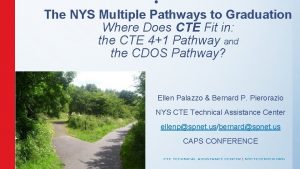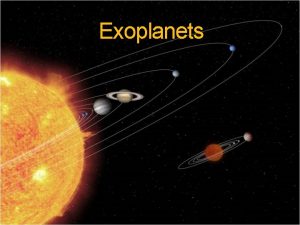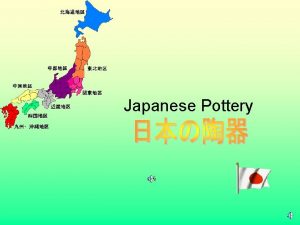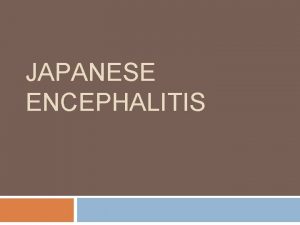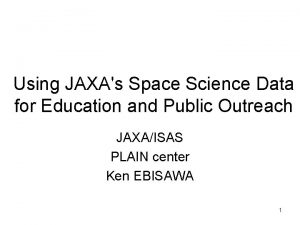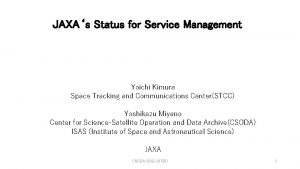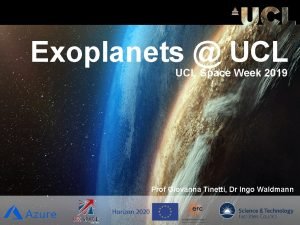Japanese Space Activity on Exoplanets JAXAs prespective Pathways





















- Slides: 21

Japanese Space Activity on Exoplanets (JAXA’s prespective) & Pathways to Habitable Planets September 16, 2009 Takao Nakagawa (ISAS/JAXA) Oct. 10, 2007 EAMA 7

Where are we from ? Are we alone ?

Scientific Goals n What are the conditions for planetary formation ? n n n n Incl. detection and characterization of habitable planets. Formation of proto-planetary disk Condensation of dust Formation and growth of planetesimals Formation of rocky planets and planetary cores Formation of giant planets Dissipation of gas Diversity and Unified Scheme

Synergy n Planetary Science n In situ measurements Hayabusa’s view of Itokawa n Astronomy n Remote Sensing AKARI’s view of HIP 7978

Strategy to reveal the conditions of Planetary Formations n Protoplanetary disk n Line spectroscopy in MIR~FIR (~mm) n n Condensation of dust and formation of planetesimals n n n Direct detection and spectroscopy : MIR coronagraph Spectroscopy using transits: Stable MIR Spectrometer Dissipation of Gas n n Thermal imaging in MIR and FIR Formation of Giant Planets n n IR Obs: Inner disk, complementary to ALMA Sensitive MIR spectrometer (H 2) Formation of Habitable planets n Detection of biomarkers

Overview of SPICA

Mission Overview n Specifications n Telescope: 3. 5 m, 5 K n n n Revolving CIB at its energy peak Foramtion of Planetary Systems Core wavelength: 5 -210 μm n MIR Instrument n n n n Far-Infrared Instrument (SAFARI) Orbit: Sun-Earth L 2 Halo Mission Life n n Including Coronagraph & Spectro. 3 years (nominal) 5 years (goal) No expendables Weight: 3. 6 t Launch: 2018

Focal Plane Instruments Herschel JWST l/dl (dv) SPICA 30000 (10 km s-1) Good 3000 (100 km s-1) Sensitivity λ 300 (100 km s-1) WIDE FOV 2 mm 200 mm Unique Capability optimized for mid- and far-infrared

Huge Gain of Sensitivity ! Photometry Spectroscopy Herschel 2. 5 orders SPICA 2 orders SPICA/ SAFARI

SPICA for the study of formation process of planets



Disk Meneralogy and Snow Line

Characterization of Giant Planets n SPICA Coronagraphy n n High Contrast (106 -7) Continuous Spectral Coverage with R~200 n n n λ ~ 3. 5 – 28μm Moderate IWA (~1”) Transit Spectroscopy n n High dynamic range (fast readout) Pointing Stability n n n FPC-G for stability IFU for good photometric stability Characterization of IR detectors n Dofocusing Model Atmosphere by Burrows et al. (2003) For 2 Mj, 100 Myr planets around G 2 V star Simulated for SPICA coronagraph (Kotani)

SPICA as an International Mission

International Collaboration Scheme n JAXA SPICA team: System Integration Telescope JAXA Integration n FPI : SAFARI FPI: MIRs+SCI ESA I/F Management n (test @<10 K) n n Science Advisory Committee Joint System Engineering Team SPICA Steering Committee ESA SAFARI Consortium System Integration Manufacturing JAXA Subsystem Integrator n FPI: BLISS n NASA Team (TBD) FPI: FPC n n n Japanese Group Korean Team (TBD) NAOJ (TBD) (test @ 80 K) European Teams Japanese Teams ※ FPI : Focal Plane Instrument SAFARI : SPICA Far-Infrared Instrument MIRs : Mid Infrared Insturuments (MIRACLE, MIRMES, MIRHES) BLISS : Background-Limited Infrared-Submikimeter Spectrograph FPC : Focal Plane finding Camera 16

Schedule Project Approval Review APPROVED CV Down Selection CV Final Selection

Japanese Perspective on Pathways to Habitable Planets

Japanese Perspective n The enterprise to achieve the ultimate goal (detection and characterization of habitable planets) should be international n n JTPF WG activity (M. Tamura’ s talk) Concrete and coherent strategy with important mile stones. n SPICA is a very important mile stone n n Scientific achievements Technology development

R&D strategy n Coronagraph n SPICA n n n Interferometry n n Enya’s talk Posters (Kotani, Haze) FITE (Shibai’s poster) Test Bed n Small satellite series n E. G. 60 cm telescope on ASNARO

Where are we from ? Are we alone ? Space Odyssey in 2018
 Euromonitor international
Euromonitor international Exoplanets the search for another earth listen
Exoplanets the search for another earth listen Exoplanets: the search for another earth
Exoplanets: the search for another earth Joint space vs cartesian space
Joint space vs cartesian space Space junk the space age began
Space junk the space age began Camera space to world space
Camera space to world space Cartesian space vs joint space
Cartesian space vs joint space Ndc to screen space
Ndc to screen space Activity 2 limiting reactants activity
Activity 2 limiting reactants activity Activity and activity coefficient
Activity and activity coefficient Aon networks
Aon networks Activity 1 introductory activity
Activity 1 introductory activity Activity 1 activity 2
Activity 1 activity 2 Activity 1 activity 2
Activity 1 activity 2 1index
1index Pathways modesto
Pathways modesto Nycte
Nycte Cerebellar pathways
Cerebellar pathways South forsyth high school pathways
South forsyth high school pathways Sdsu pathways
Sdsu pathways Lambert high school pathways
Lambert high school pathways Pathways to desistance
Pathways to desistance
















